

23 Jun Is Laminate Flooring Waterproof?
Water has always been the worst nightmare for floorboards since time immemorial. Any wood based flooring is known to absorb water and swell, rot, mould and ultimately require repairing. Water resistant technology has evolved over time, but would it be too daring to hope for waterproof laminate flooring?
Most unfortunately, the answer is no, laminate floors are not waterproof (although certain brands falsely claim to be waterproof). However the vast majority of laminate floorboards are very water resistant, meaning they can last a significant time with water without absorbing moisture. This article will explain exactly what that means and help you decide whether the “waterproof” laminate flooring is the right choice for you!
Buyers Beware – Waterproof Laminate Flooring vs Water Resistant Laminate Flooring
You may have heard of terms like “100% waterproof surface” or”Extremely water resistant”. Is that the same thing as waterproof? Unfortunately, water-resistant and waterproof surface does not mean the floors are completely waterproof. Here’s the difference:
Waterproof – Waterproof laminate flooring is 100% impervious to any form of water. No amount of spills or moisture will ever harm your floors. This quality can be found in tiles, hybrid floors and vinyl floors.
Water Resistance – These floors make up the vast majority and are able to partially resist water damage, usually measured in ‘hours of water resistance’ before they inevitably absorb water. Higher quality water-resistant laminate flooring has longer hours of certification against water.
Some brands claim to have 100% waterproof laminate flooring despite having an expansion rate above 4% when exposed to water for 24 hours. This is false and misleading advertising, as the planks can still be damaged by moisture. It is important to double-check with test reports in order to confirm the accuracy of what certain waterproof laminate flooring brands claim.
Construction of Laminate Flooring:
Laminate flooring was first introduced as a recycled wood floor covering made from scrap timber. Over many years, they have developed high scratch-resistant surfaces and moisture-resistant fibres. Laminate floors are made up of three layers:
- Wear Layer – The surface of all laminate floors (and almost all wood look floors) are coated in a thin lacquer of aluminium oxide. This provides a scratch-resistant and water-resistant surface.
- Print Layer – Advanced printing and embossing technology enables your laminate floor to look and feel just like real timber!
- Fibreboard – The material composition itself is also known as a high density fibreboard (HDF) which is made up of fused wood pulp.
Finally, laminate flooring is categorised under floating floors, which essentially means that they do not need glue or nails during installation. Instead, floating floors utilise an efficient click lock system which pieces each floorboard together like a jigsaw puzzle.
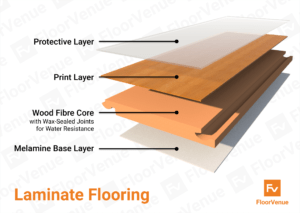

AquaFloor Laminate – Australia’s Most Water Resistant Laminate Flooring
AquaFloor branded laminate flooring was introduced into the Australian market in early 2021, offering 7 Days (168 hours) of water resistance, making them almost a waterproof laminate. This means you would have to expose AquaFloor Laminate flooring to water for over a week for any swelling or moisture-related damages to appear. The Water-resistant AquaFloor is very popular in both commercial and residential use for this reason.
Other laminate flooring brands with great water resistance include Aquawood, Cloudwalk Aquamarine, Clever Hydro, and Kronoswiss Aquastop. Most laminate floors have 24 – 48 hours which is already great.
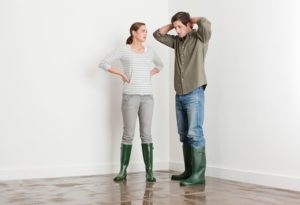

Waterproof Alternatives vs AquaFloor Laminate
Now that we understand the difference between waterproof and water resistant, let’s explore some pros and cons of alternative options to waterproof laminate flooring.
AquaFloor Laminate vs Tiles
Porcelain tiles and Ceramic tiles are the trusty old solutions for kitchens and bathrooms. Some modern designs are beginning to adopt smooth tile flooring right through the house, minus bedrooms. How does the waterproof Laminate compare?
Pros:
- More Affordable – Laminate flooring is significantly more affordable than tiles in both material and installation. Tiles are also a lot more permanent and hence more costly to renovate in the future.
- Warmer – Tiles not only feel more cold, but indeed are less insulating than laminate flooring. This makes it less desirable than wood flooring. (Note: low insulation can be a benefit for underfloor heating)
Cons:
- Durability – AquaFloor Laminate (Although suitable for heavy commercial use) is not as scratch and dent resistant as porcelain, ceramic and stone tiles.
- Fully Sealed – Even the waterproof AquaFloor Laminate range cannot overcome the hurdle of sealing the floors to stop water from leaking into the subfloor, which tiles have no problem handling.
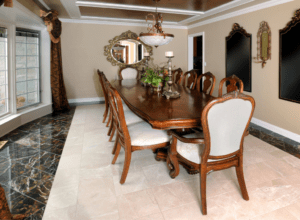

AquaFloor Laminate Flooring vs Hybrid Flooring
Hybrid flooring is an innovative product which is also 100% waterproof but looks and feels like real wood. Made up of a stone and plastic composite (SPC) or wood or plastic composite (WPC), hybrid flooring has rocked the market in recent years. How do they compare with the newer AquaFloor Laminate floors?
Pros:
- Durability – AquaFloor Laminate floors have a wear layer which is significantly more abrasion resistant than hybrid flooring which means they won’t scratch as easily. (AquaFloor offers AC4 and AC5 abrasion class)
- Installation Ease – Unlike hybrid floors, laminate ranges don’t require an extremely even subfloor. This can save you subfloor levelling costs.
- Dimensional Stability – AquaFloor waterproof laminate flooring wont swell or warp from temperature fluctuations compared to hybrid flooring.
Cons:
- Underlay – Hybrid flooring often comes with pre-attached acoustic underlay, whereas laminate ranges (including AquaFloor) do not offer. This means you’ll need to purchase acoustic underlayment separately if required.
If you would like to learn more, you can view our Hybrid Flooring Range.


AquaFloor Laminate Flooring vs Luxury Vinyl Planks
Luxury Vinyl Planks (LVP) are made fully of synthetic PVC and are great for most residential and commercial applications. Aside from being waterproof, vinyl flooring tends to be soft and slightly springy underfoot.
Pros:
- Abrasion Resistant – AquaFloor Laminate flooring is much stronger against scratches and dents compared to the softer luxury vinyl flooring.
- VOC Emissions – Vinyl floors are made of synthetic materials, some of which may emit respiratory irritants. Laminate ranges have less VOC emissions than vinyl floors.
- Dimensional Stability – AquaFloor Laminate flooring is much less susceptible to swelling or warping from changing temperatures compared to vinyl planks.
- Dearer – Whilst the material price of vinyl and laminate floors are similar per square metre, the installation costs of vinyl flooring is higher as it requires a glue-down installation.
Cons:
- Impact Cushioning – Vinyl flooring is softer than laminate flooring which means that in the event of a fall, you will be less likely to be injured. This makes it more suitable for aged care centres or hospitals.
- Cleaning – Luxury vinyl floors may have anti staining properties which make them easier to clean and maintain.
You can view our range of Luxury Vinyl Planks (LVP) and learn more!
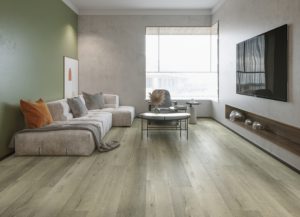

AquaFloor Laminate Flooring vs HydroPro Engineered Timber
The innovative HydroPro Timber fuses lacquered hardwood onto a limestone based core instead of the usual plywood. This makes it even more structurally durable and fully waterproof from below, whilst the surface is protected from spills with 8 layers of lacquer. How do the two ranges compare?
Pros:
- Durability – Whilst both have a strong wear layer, a real timber surface is slightly less scratch and dent resistant than synthetically manufactured laminate flooring. This means the heavy commercial wear rated AquaFloor Laminate flooring takes the win here.
- Waterproofing – Both HydroPro Timber and AquaFloor Laminate are virtually impervious to any form of moisture or water. However, HydroPro Timber is still made up of real hardwood which means that if the lacquer is scraped off it will still absorb moisture. As such, AquaFloor Laminate is the winner, although it is very close.
- Affordability – HydroPro Timber is considerably more expensive than AquaFloor Laminate flooring since it has real timber. Hence, the AquaFloor Laminate wins again.
Cons:
- Appearance – Since all laminate floors are artificially manufactured through printing technology and fibreboards, the HydroPro Timber with real gorgeous hardwood and European oak veneer surfaces are more realistic than a replica.
- Property Value – Laminate floors do not increase the value of your property unlike real timber. HydroPro Timber is not only beautiful but will provide return on investment.
Interested in viewing and learning more about the Water-Resistant HydroPro Timber?
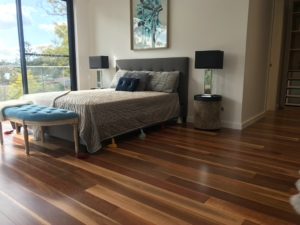

Conclusion – Is Waterproof Laminate Flooring Any Good?
In conclusion, waterproof laminate flooring is fully moisture impervious and offers the most hard wearing surfaces out of all the hard flooring types. Just as waterproof hybrid floors became the most popular over the last five years, we predict the next generation technology waterproof laminate to become the number one in the market within the next five years.
As such, waterproof laminate flooring is not just good, it’s great!
You can also view other non-waterproof laminate flooring options, for a more comprehensive range of colours and designs.




























